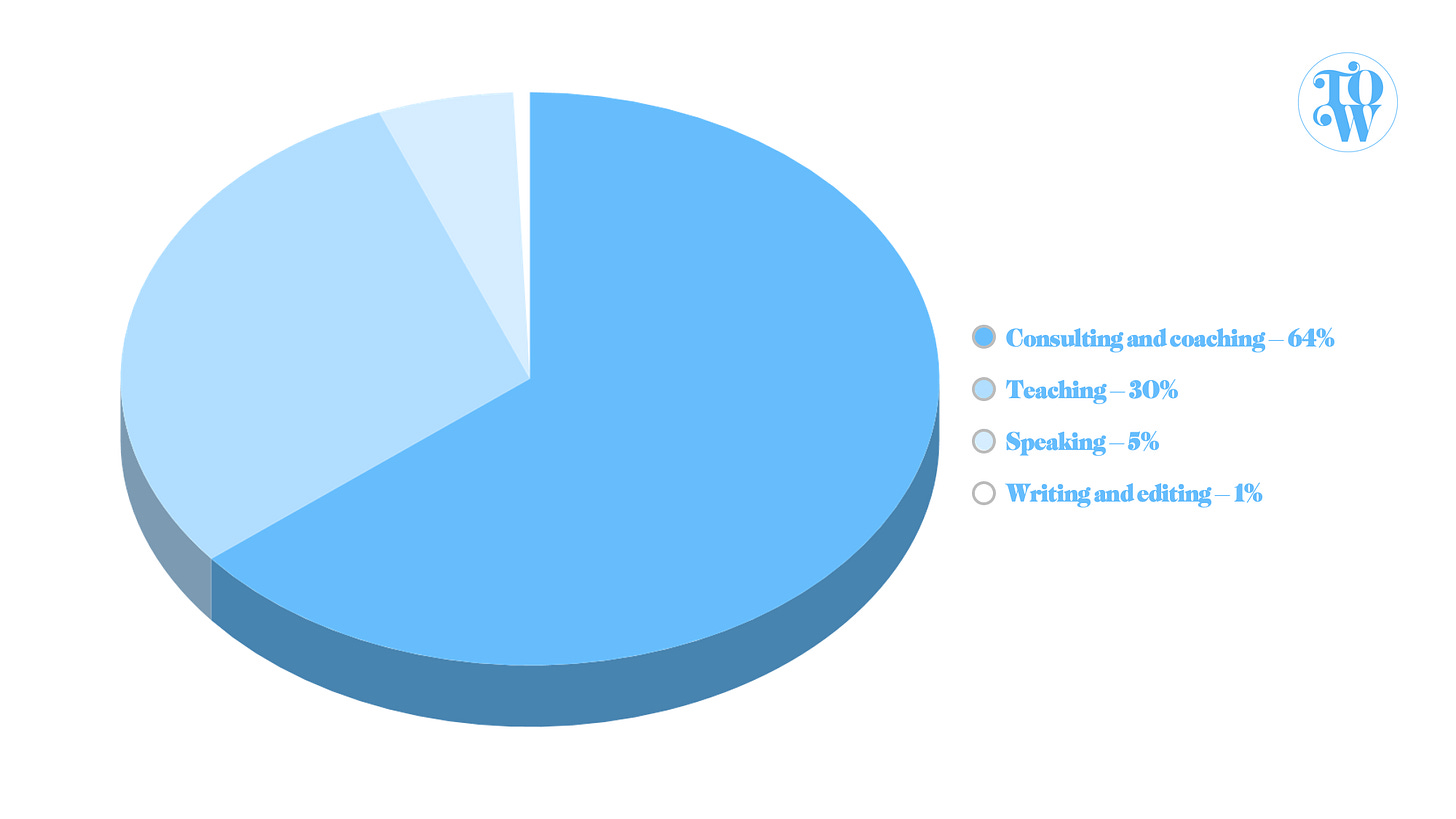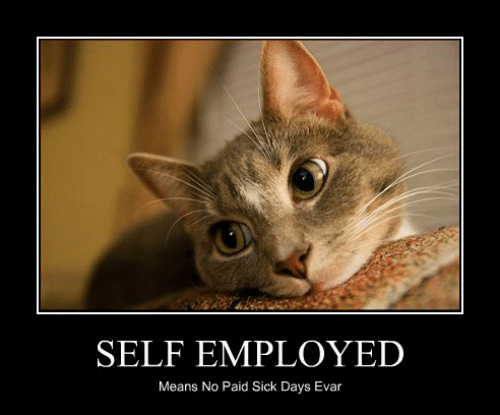Yes, I’m self-employed. No, that’s not a euphemism for ‘unemployed.’
I break down the revenue streams from my first full year of self-employment, as well as how I diversified my income.
Hey y’all! Anita here. The longer I look at my dek for this week’s newsletter, the more it reads like those laughably terrible get rich quick ads on YouTube à la Tai Lopez. But...the more you learn, the more you earn! If you keep reading, I’ll share *three things* you can implement TODAY no matter where you are. Becoming a gazillionaire can happen faster than you think if you know the proven steps. Dream big 🌈 🤑
My outsider’s approach
In all seriousness, though, I feel incredibly grateful to have a career that allows me the autonomy and flexibility to pursue every facet of journalism I love, from editorial to business and everything in between. Far from being a meaningless title, “self-employed journalist” is the most accurate — but still inadequate — catchall description of an interdisciplinary career path that’s becoming more popular in embattled journalism industries around the world. It’s a growing movement that’s led by status quo-challenging journalists like me who know that fundamental changes need to happen in our industry.
To be sure, “self-employed” is an amorphous term, especially in Canada’s historically traditional and relatively centralized journalism industry, which has long established a well-worn path to success. But that path has been disrupted, particularly in the last decade, due to increasingly precarious employment, the rise of the “passion economy” and niche publications, and industry-wide exhaustion with media consolidation and broken business models that prioritize quantity of clicks over quality of journalism.
“Self-employed” means different things to different people. For me, it involves four main categories: (1) teaching; (2) speaking; (3) consulting and coaching; (4) writing, reporting and editing. During my first full year of self-employment from January 2020 to January 2021, I made over six figures across my four main revenue streams, which is more than I’ve earned in any previous full-time job outside of one role I had in New York City (media salaries in NYC and Washington, D.C. are widely known to be much higher than elsewhere). Here’s the breakdown:
I’m not out here trying to make bank, but I am trying to earn a sustainable long-term income — at a level I deserve based on my experience and profile — doing what I love. The vast majority of the opportunities I get are from inbound requests, which fortunately helps me preserve more of my time for working and less for hustling.
As Anita Zielina said at the Splice Beta Online media conference last year, “We don’t fit into boxes anymore.” The director of strategic initiatives at the City University of New York’s Craig Newmark School of Journalism succinctly articulated a new media world of jobs and paths that live at the intersection of editorial, business, strategy and technology. Like me, these people want to serve communities and make an impact, while also earning a living.
But for every leader in journalism innovation, like Anita, who understands what I do...
...there are many more who don’t, including this Canadian journalism student who reached out with an assumption-heavy interview request soon after I launched The Other Wave:
You all know the actual reasons why I started my newsletter, but I don’t blame this student for thinking otherwise, given that my type of career path is only starting to gain prominence in Canada.
My insider’s approach
Revelations from the Jan. 12 arbitration decision in the matter of CBC vs. CMG on behalf of journalist Ahmar Khan, as well as other recent news stories that showed how toxic some Canadian newsrooms can be, has eroded the trust that many journalists — especially those who aren’t in management positions — had in these institutions. Less-than-adequate working conditions provide yet another incentive for journalists to pursue alternative career paths beyond the status quo.
Last week, I spoke to a mid-career reporter with a full-time job at a major newspaper here in Toronto about how to responsibly diversify his income streams, after he scheduled a meeting with me to ask for my advice. The reporter said he decided to approach me because he was inspired by my success in this non-traditional career path. Indeed, more and more journalists from establishment media outlets are striking out on their own, such as former CP24 reporter Brandon Gonez.
In the summer of 2019, I left my most recent permanent job to consult and teach full-time. Back then, I had an intense desire to take what I’d learned from my previous experiences in leadership roles at digital media outlets, and apply those learnings to my own news products. An independent career path enables me to pursue journalism entrepreneurship on my terms.
Certainly, there are cons to self-employment, including no benefits or job security, so it’s not for everyone. But I must say I’m not overly concerned because of my broad network and the fact that I’ve invested in professional relationships that have led to in-bound requests and other opportunities so far 🤞. Besides, many rank-and-file journalists — especially younger ones — are so poorly compensated, and are so often forced to take on low-paying contract work with no benefits and occasionally long hours, that I’d rather take the risk of self-employment because there’s no guarantee you’ll earn more under an employer these days.
The pros, on the other hand, are plentiful. As someone who’s self-employed, my boss lets me call the shots, so I can pick and choose work I enjoy doing (I’m a firm believer that when you do what you love, you’ll excel in it). I get to collaborate with many different groups and people, including some of the sharpest minds in journalism around the world. Because I’m not beholden to one company, I can be bolder in my advocacy work and criticism of status quo practices in Canadian journalism. I also don’t have to work with jerks; while it’s very important to be able to collaborate with colleagues who have different opinions or working styles than you, nobody should be forced to tolerate abusive or dishonest behaviour, especially when it’s systemic.
I wouldn’t rule out working for an employer in the future, but if and when I do, it’ll be for a company that shares my values.
Speakers’ corner
Based on the amount of feedback I received, the last edition of The Other Wave resonated with quite a few of you, including subscriber Aaron Leaf. Aaron is director of content development for OkayAfrica, which I consider one of the most effective publications when it comes to knowing its audiences and serving them well. Here’s what he had to say:
As usual, your newsletter is really resonating. Particularly this part: ‘Media startups become vanity projects when founders make decisions — either consciously or unconsciously — that serve their ego more than their community.’
I've had this happen so many times in my career that I've come to expect it and have instinctively built up a polite arsenal of techniques for steering organizations away from it. I'd bet that my interest in audience metrics comes from trying to build better arguments against vanity projects.
In my community
I’m proud to be on the jury for the Canadian Journalism Foundation’s inaugural Digital News Innovation Award, which recognizes innovations that have a demonstrated impact in advancing the quality of digital journalism at home. Deadline to apply is Feb. 19.
U.S. President Joe Biden’s recent inauguration reminded me of a panel I spoke on last month, called “Global conversation on how the U.S. election is being explained to the world.” It was hosted by the USC Annenberg Center on Communication Leadership and Policy on Dec. 15, the day after the Electoral College confirmed Biden’s victory.
In light of the arbitration decision in the dispute between CBC and journalist Ahmar Khan, my organization Canadian Journalists of Colour endorsed this editorial written by Marion Warnica, host of CBC’s The World This Hour and head of the Canadian Journalists Anti-Racism Coalition. Seven groups are united under the coalition, including CJOC.
Cool stuff I like
I’ve been on a Fran Lebowitz kick since watching Martin Scorsese’s new Netflix docuseries, Pretend It's a City, about the legendary New York writer. I highly recommend watching Scorsese’s first — but equally hilarious and insightful — documentary about Lebowitz, a lesser known gem called Public Speaking.
I recently saw Geoffrey, the cute pink robot that provides contactless delivery, roaming the sidewalks of my east end Toronto neighbourhood. The company behind Geoffrey says it reduces delivery costs for restaurants while emitting zero emissions, which is a win for embattled local businesses during COVID-19 and for an embattled planet during a climate crisis.
Dan Price, CEO of Gravity Payments, wrote a must-read LinkedIn post in which he compares how his payment processing company handled revenue declines throughout the pandemic, with how his venture capital-backed competitor dealt with the same challenges. Spoiler alert: It all comes down to ethics.
Last thought
How you can support The Other Wave
My professional mission has always been to support the global movement towards more thoughtful, impactful news coverage, and all the ways that manifests. If The Other Wave gets you to think even a little differently about journalism, especially in Canada, then I will have accomplished what I set out to do. And if TOW gets you to take action and support Canadian media outlets — especially ones that strive to be innovative and inclusive — I will have exceeded my expectations.
If my values and goals resonate with you, please consider supporting fiercely independent media analysis that fills in gaps in coverage of the Canadian journalism landscape. How? Feel free to provide feedback, pass along resources, donate money or simply share this newsletter with your friends.





